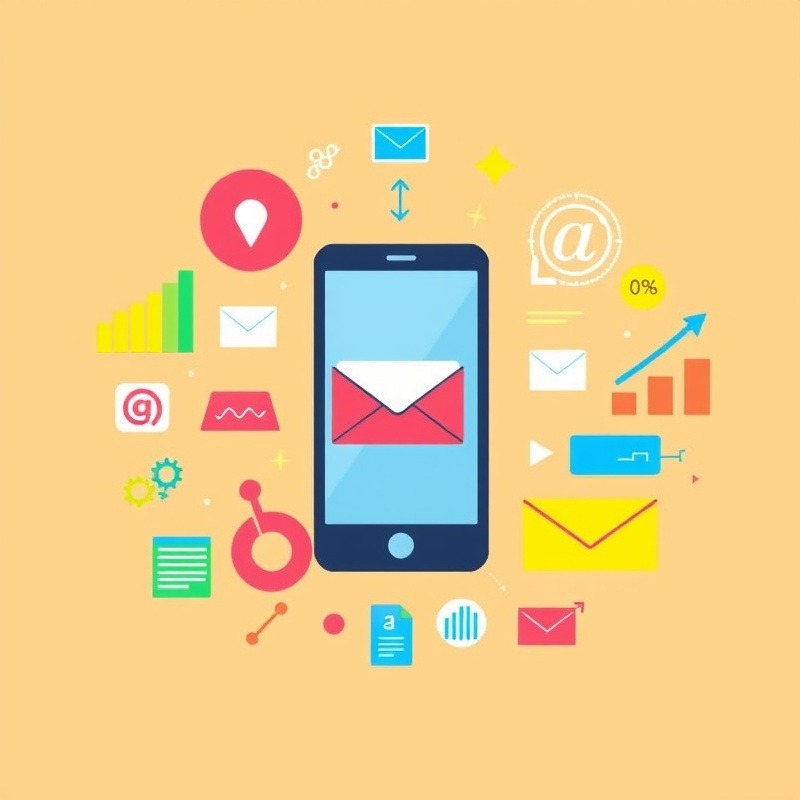Picture this: Your inbox pings with a new email. You open
it, and within seconds, you're captivated. You're clicking through, eager to
learn more. That's the magic of effective email marketing – and it's exactly
what we're going to help you achieve today. ?
Key Takeaways
- Craft irresistible subject lines that demand attention
- Personalize your emails for a 14% higher clickthrough rate
- Optimize for mobile to reach 81% of readers effectively
- Use compelling calls-to-action (CTAs) to drive engagement
- Leverage segmentation for targeted, relevant content
- A/B test your emails to continuously improve performance
- Make unsubscribing easy to maintain a healthy, engaged list
- Build drip campaigns to nurture leads effectively
- Pay attention to deliverability and layout for maximum impact

The Email Marketing Landscape: More Powerful Than Ever
In a world dominated by social media and instant messaging, you might think email marketing is losing its edge. Think again! Email marketing continues to be a powerhouse, offering an astounding 4200% ROI – that's $42 for every $1 spent. ?
But here's the catch: With over 300 billion emails sent daily, standing out in a crowded inbox is tougher than ever. That's where our expert tips come in, designed to help you craft emails that not only get opened but clicked through with enthusiasm.
The Trifecta of Email Open Rates: Sender, Subject, and Preview
Imagine your email as a gift. The sender's name is who it's from, the subject line is the wrapping paper, and the preview text? That's the tantalizing ribbon that makes your reader want to tear it open immediately.
Let's break it down:
- 42% of email subscribers look at the sender's name first
- 34% focus on the subject line
- 24% zero in on the preview text
Clearly, mastering all three elements is your ticket to skyrocketing open rates. Let's dive deeper:
Your Sender Name: The Trust Factor
Your sender name is like your email's handshake – it's the first impression that builds trust. Make it count:
- Use a recognizable name (your brand or a familiar person)
- Be consistent across campaigns
- Consider using a person's name for a more personal touch (e.g., "Sarah from [Brand]")
Example: Instead of just "Newsletter," try "Tim from TechWizard"
Crafting Subject Lines That Demand Attention
Your subject line is your first (and sometimes only) chance to make an impression. Here's how to make it count:
- Keep it short and sweet: Aim for 41 characters or less – it's the sweet spot for mobile users.
- Create urgency: "Last Chance: 50% Off Ends Tonight!" sparks immediate action.
- Ask questions: "Ready to double your productivity?" engages curiosity.
- Use numbers: "5 Secrets to Effortless Weight Loss" is specific and intriguing.
Example: Instead of "Monthly Newsletter," try "Insider Tips: 3 Ways to 10x Your Business This Month"
Pro Tip: Use emojis sparingly to add visual pop, but don't overdo it!
Preview Text: Your Secret Weapon
Think of preview text as your subject line's wingman. It's that snippet of text that appears right after the subject line in most email clients. Here's how to make it work for you:
- Keep it between 40 to 130 characters
- Make it complement your subject line, not repeat it
- Include a clear value proposition or call-to-action
- Test how it looks on both mobile and desktop clients
Example: Subject: "Your Summer Adventure Awaits!" Preview: "Exclusive 48-hour sale on tropical getaways. Book now and save 50%!"
Remember, if you don't set preview text, most email clients will pull the first few lines of your email body. Don't let "Can't see this email?" be the first thing your readers see!
The Power of Synergy
The real magic happens when your sender name, subject line, and preview text work together in perfect harmony. They should tell a cohesive story that compels your reader to open, click, and act.
Example: Sender: "Sarah from TravelDreams" Subject: "? [First Name], Your Paradise is Calling!" Preview: "Exclusive 48-hour sale on Bali retreats. Open for your personalized itinerary!"
Can you feel the urge to open that email? That's the power of a well-crafted email trifecta!
The Power of Personalization
Imagine receiving an email that speaks directly to you, addressing your specific needs and interests. That's the magic of personalization, and it can increase clickthrough rates by up to 14%.
- Use your subscriber's name in the subject line and body
- Reference past purchases or browsing history
- Tailor content based on demographics or preferences
Example: "Sarah, we've handpicked these workout plans just for you based on your fitness goals!"
Mobile Optimization: Don't Leave 81% of Readers Behind
With 81% of people checking their email on smartphones, mobile optimization isn't just nice to have – it's essential.
- Use a responsive design that adapts to any screen size
- Keep your subject lines short (remember, 41 characters or less)
- Use large, easily tappable buttons for CTAs
- Break up text into short, scannable paragraphs
Compelling Calls-to-Action: The Click Magnets
Your CTA is where the magic happens. Make it impossible to resist:
- Use action-oriented language: "Get Started," "Claim Your Spot," "Unlock Your Potential"
- Create contrast: Make your CTA button stand out visually
- Be specific about the value: "Start Your Free 30-Day Trial" is better than "Sign Up"
Example: Instead of "Learn More," try "Discover Your Path to Financial Freedom"
Segmentation: The Key to Relevance
Not all subscribers are created equal. Segmentation allows you to send targeted, relevant content that resonates with specific groups:
- Divide your list based on demographics, behavior, or preferences
- Create tailored content for each segment
- Use dynamic content to personalize within a single email campaign
Example: A fitness company might segment their list into "Beginners," "Intermediate," and "Advanced" users, sending workout tips appropriate for each level.
The Art of Timing
Timing can make or break your email campaign. While there's no one-size-fits-all answer, here are some guidelines:
- Tuesday, Wednesday, and Thursday tend to have higher open rates
- The best times are often 10 AM, 8 PM, and 2 PM
- However, your audience is unique – use A/B testing to find your sweet spot
A/B Testing: Your Path to Constant Improvement
Think of A/B testing as your email marketing laboratory:
- Test one element at a time (subject lines, CTA placement, images)
- Use a significant sample size for reliable results
- Implement winning strategies in future campaigns
Pro Tip: Start with your subject lines – they're the gateway to your email content.
Content That Converts
Your email content should be a perfect blend of value and persuasion:
- Provide genuine value: Tips, insights, or exclusive content
- Use storytelling to engage emotions
- Keep it concise: Respect your reader's time
- Use visuals: Images and videos can increase clickthrough rates by 65%
Example: Instead of just announcing a sale, share a customer success story that showcases the transformative power of your product.
Make Unsubscribing Easy: The Counterintuitive Secret to List Health
Here's a truth bomb: Not everyone will want to stay on your list forever. And that's okay! The average unsubscribe rate across industries is about 0.24%. Embracing this fact can actually boost your email marketing effectiveness.
Why? Because an engaged list is infinitely more valuable than a large, uninterested one. Here's the scoop:
- Uninterested subscribers lead to lower open rates and engagement
- They might mark your emails as spam, hurting your deliverability
- From February 2024, Google requires a one-click unsubscribe option
Pro Tip: Make your unsubscribe link visible and easily clickable, especially on mobile. It's not just good practice – it's soon to be a requirement!
Decide on Frequency and Goals: The Foundation of Your Strategy
Before you hit "send" on your next campaign, take a step back and consider:
- How often will you email? Weekly? Monthly? Quarterly?
- What's the goal of each email? New products? Sales? Tips and advice?
Remember, B2B audiences might prefer less frequent, more substantial communications. The key? Experiment and find your sweet spot.
Build a Schedule: Your Email Marketing Roadmap
Shockingly, 47% of organizations don't have a defined marketing strategy. Don't be one of them! Create an editorial calendar that includes:
- Planned send dates for your campaigns
- Email topics and themes
- Required content (images, videos, etc.)
This roadmap will keep you consistent and help you plan content that aligns with your overall marketing goals.
Create Separate Emails for Each Goal: Laser-Focused Messaging
Each email should have a clear, singular purpose. Are you:
- Increasing brand awareness?
- Driving traffic to your website?
- Making a sale?
By creating separate emails for each goal, you ensure your message is targeted and your CTA is crystal clear.
Example: If your goal is driving website traffic, focus on showcasing recent blog posts, lead magnets, or new product pages.
Build Drip Campaigns: Nurture Leads on Autopilot
Drip campaigns are like a series of friendly conversations that guide your leads through the sales funnel. Here's a simple structure:
- Welcome email: A warm introduction to your brand
- Value email: Share helpful content or product information
- Offer email: Introduce a free trial, discount, or exclusive content
Pro Tips for Drip Campaigns:
- Segment your audience (active customers, prospects, past customers)
- Create a stellar welcome email for new subscribers
- Set up automation rules based on subscriber engagement
- Customize content for each audience segment
- Include clear CTAs in every email
- Monitor analytics to refine your approach
Pay Attention to Deliverability: Ensure Your Emails Reach the Inbox
Did you know that 16.9% of B2B marketing emails never reach an inbox? Here's how to boost your deliverability:
- Only collect email addresses from people who've opted in
- Choose a reputable email service provider (e.g., Mailchimp, Constant Contact, AWeber)
- Time your sends wisely (hint: weekends might not be best for B2B)
Layout Matters: Design for Readability and Impact
With more people reading emails on the go, your layout needs to be mobile-friendly and easy to scan:
- Embrace white space for better readability
- Use short paragraphs, headlines, and bullet points
- Optimize image sizes for faster loading
- Stick to a 14-16 px font for body text
Pro Tip: Consider incorporating video – 91% of businesses use it in marketing, with 87% reporting a positive impact on sales.
Avoid Spam Filters: The Art of Getting Past the Gatekeepers
Certain words can trigger spam filters, potentially derailing your carefully crafted campaigns. Here's how to stay in the clear:
- Avoid overused phrases like "free," "help," "percent off," and "reminder"
- Rephrase creatively: "Get your free e-book now!" becomes "Download your e-book now!"
- Skip the ALL CAPS in subject lines – it looks spammy
- Use symbols (like $, !, %) sparingly
- Keep your email list clean by only emailing engaged subscribers
- Segment your lists for more targeted content
The Power of Questions: Spark Curiosity and Boost Open Rates
Want a simple trick to increase open rates by 10%? Ask a question in your subject line! It taps into our natural curiosity and makes us want to learn more.
Examples:
- For a hiking gear store: "Are you all set for your next adventure?"
- For beginners: "Need a hand picking the perfect hiking gear?"
By asking questions that matter to your segments, you create emails that feel like personal conversations.
See How Digital Marketing All Can Drive More Traffic to Your Website
- Brand Voice Strategy – Let our team help you create your brand voice to attract your ideal customer.
- Keyword Weak Spot Report – Let our team show you where you can gain additional traffic that you are missing.
- SEO - unlock more SEO traffic. See real results.
- Content Marketing - our team creates epic content that will get shared, get links, and attract traffic.
- Paid Media - effective paid strategies with clear ROI.
Measuring Success: Beyond Open Rates
While open rates are important, clickthrough rates (CTR) are the true measure of engagement. Industry averages vary, but aim for:
- E-commerce: 2.1%
- Software and Tech: 2.5%
- Marketing and Advertising: 2.7%
Remember, even small improvements can lead to significant results over time.
Frequently Asked Questions
Q: How often should I send emails?
A: It depends on your audience, but start with once a week and adjust based on engagement metrics. Quality always trumps quantity.
Q: Is it okay to buy email lists?
A: Absolutely not! Not only is it often illegal, but it's also ineffective and can damage your sender reputation.
Q: How can I grow my email list organically?
A: Offer valuable lead magnets, use pop-ups on your website, and promote your newsletter on social media. Always focus on providing value to incentivize sign-ups.
Q: What's considered a good click-through rate (CTR)?
A: While it varies by industry, the average CTR across all sectors is about 2.62%. E-commerce typically sees around 1.74%, while social networks and online communities might hit 3.24% or higher.
Q: How do I calculate my email CTR?
A: It's simple math: (Number of clicks / Number of emails sent) x 100 = CTR%. For example, if you send 1000 emails and get 100 clicks, your CTR is 10%.
Q: What factors influence email CTR?
A: Key factors include your CTA, content relevancy, subject line, design, and timing. Each element plays a crucial role in engaging your audience.
Q: How can A/B testing boost my CTR?
A: By testing different versions of your emails, you can identify what resonates best with your audience. Test elements like subject lines, layouts, images, CTAs, and offers. Start with a small sample, then roll out the winner to your full list.
Q: How many touchpoints to conversion should there be according to email marketing best practices?
A: Five to six touchpoints is generally a good place to start. However, some campaigns may only require three touchpoints, while others might need eight or more. It depends on your product, audience, and sales cycle.
Q: If I follow email marketing best practices, will my conversions increase?
A: While we can't guarantee specific results, following these best practices significantly increases your chances of success. These strategies have been proven to work across various industries.
Q: Do the best practices for email marketing change frequently?
A: The core principles remain relatively stable, but tactics can evolve with technology and user behavior. Stay updated with industry trends, but always focus on providing value to your subscribers.
Your Launchpad to Email Marketing Greatness
Imagine opening your analytics dashboard to find clickthrough rates soaring, conversions multiplying, and your business thriving – all powered by the emails you've crafted using these strategies. That future is within reach.
Remember, email marketing isn't just about sending messages; it's about building relationships, providing value, and inspiring action. With each email you send, you're not just sharing information – you're opening doors to opportunities, growth, and success for your subscribers.
So, are you ready to transform your email marketing from good to extraordinary? The strategies are in your hands. The potential is limitless. Your next game-changing campaign is just a "Send" button away.
Will you seize this opportunity to revolutionize your email marketing and watch your business soar to new heights?
I hope you enjoy reading this blog post. If you want my team to just do your marketing for you, click here.
 Add Row
Add Row  Add
Add 







